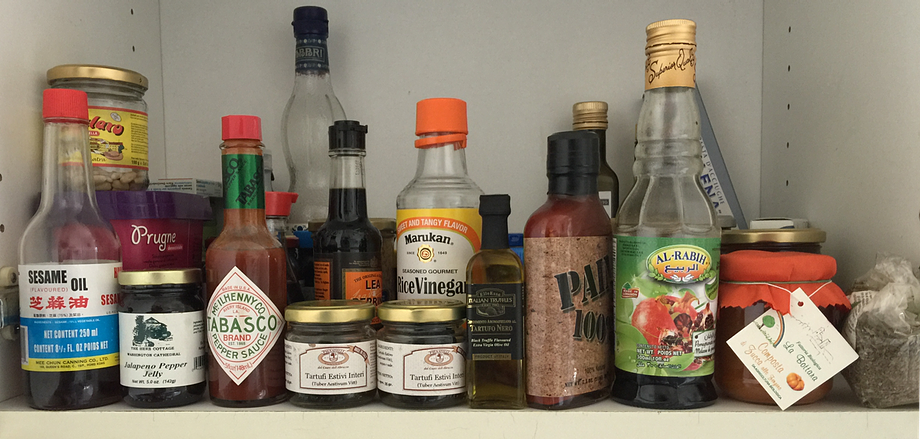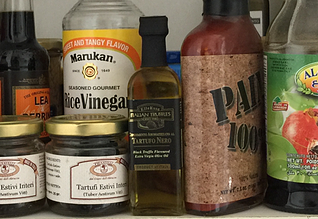
Podcast: Play in new window | Download (Duration: 20:47 — 14.7MB)
Subscribe: Google Podcasts | Spotify | Android | RSS | More
 The heat here in Rome has been something the past couple of weeks. Not up to 2003 of blessed memory, but hot nevertheless. The last thing I needed was for the fridge to start playing up, but it did, making horrible noises. Ignoring the disaster foretold, I defrosted the darn thing, which not only solved the problem (temporarily) but also provided inspiration for this episode of Eat This Podcast. At the back of the fridge I found things I had completely forgotten. That prompted me to dig around in the back of the store cupboard too, where there were lots of other things of which I was vaguely aware, but not aware enough actually to have used them. All of which prompted a musing on store-cupboard essentials, gifts from well-meaning friends, and the whole neophilia-neophobia tension. I hope I didn’t ramble on for too long.
The heat here in Rome has been something the past couple of weeks. Not up to 2003 of blessed memory, but hot nevertheless. The last thing I needed was for the fridge to start playing up, but it did, making horrible noises. Ignoring the disaster foretold, I defrosted the darn thing, which not only solved the problem (temporarily) but also provided inspiration for this episode of Eat This Podcast. At the back of the fridge I found things I had completely forgotten. That prompted me to dig around in the back of the store cupboard too, where there were lots of other things of which I was vaguely aware, but not aware enough actually to have used them. All of which prompted a musing on store-cupboard essentials, gifts from well-meaning friends, and the whole neophilia-neophobia tension. I hope I didn’t ramble on for too long.
Some the things that did not make it into my rambles:
- The whole business of gleaning that gave rise to grano arso I find fascinating. Gleaners were surely the first dumpster divers. The practice is enshrined in the Old Testament and I like the idea that richer landowners sometimes deliberately left fruit behind in their vineyards and orchards and grain in their fields that the poor might gain. I am not competent to say anything more about Ruth than that I find her’s a very moving story.
- The other story behind grano arso is that it was not the stubble-cleansing fires that burnt the gleaned wheat grains but rather the heat from steam-powered threshing machines. Probably both. I don’t know whether any Pugliese who remembers the old stuff would agree that smoked or oven-burnt flour is in any way a substitute, but I like it.
- Here’s a recent entry point to my adventures with grano arso.
- I do feel rather ashamed about the garum thing. After my podcast Lauren Stacy Berdy was so kind to send me a bottle of her American garum and I still haven’t tried it. But I will, and soon, I promise. And perhaps I’ll report back here.

 The Pamir Mountains of Central Asia hold a fascinating diversity of food crops. Exploring the area in the early years of the 20th century the great Russian botanist Nikolai Vavilov became convinced that this was where “the original evolution of many cultivated plants took place.” Soft club wheat, with its short ears, rye, barley, oil plants, grain legumes like chick peas and lentils, melons and many fruits and vegetables; all showed the kind of diversity that Vavilov said pointed to the places where they were first domesticated. As he wrote, “it is still possible to observe the almost imperceptible transition from wild to cultivated forms within the area.”
The Pamir Mountains of Central Asia hold a fascinating diversity of food crops. Exploring the area in the early years of the 20th century the great Russian botanist Nikolai Vavilov became convinced that this was where “the original evolution of many cultivated plants took place.” Soft club wheat, with its short ears, rye, barley, oil plants, grain legumes like chick peas and lentils, melons and many fruits and vegetables; all showed the kind of diversity that Vavilov said pointed to the places where they were first domesticated. As he wrote, “it is still possible to observe the almost imperceptible transition from wild to cultivated forms within the area.”